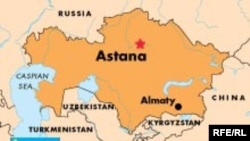A statement posted on the ministry's website says 66 other children infected with HIV, the virus that leads to AIDS, have been registered in the area, including one who was taken abroad for adoption.
In a separate statement issued on October 2, the Health Ministry said AIDS experts from Slovakia's Presov University were expected in southern Kazakhstan in November to help authorities cope with the outbreak.
The children were contaminated at hospitals in Shymkent, the Southern Kazakhstan region's main city.
Officials believe they were infected either through tainted syringes or transfusions of contaminated blood.
Criminal charges have been brought against several medical workers and hospital staff members.
President Nursultan Nazarbaev September 20 dismissed Health Minister Yerbolat Dosaev and Southern Kazakhstan Region Governor Bolat Jylkyshiev as the death toll mounted. Both men are accused of negligence in handling the outbreak.
Dozens of children have been diagnosed with the HIV virus in the past several months.
The UN On AIDS
The United Nations has issued its annual report on the AIDS epidemic. Here are some of its findings:
- There are currently an estimated 40.3 million people living with HIV, the virus that causes AIDS. Of those, 17.5 million are women and 2.3 million are children under the age of 15.
- There were an estimated 4.9 million new HIV infections in 2005, including 700,000 children under the age of 15.
- An estimated 3.1 million people, including 570,000 children, died of AIDS in 2005.
- According to the report, more than 25 million people have died of AIDS worldwide since the disease was recognized in 1981.
- In Eastern Europe and Central Asia, the number of HIV-positive people reached 1.6 million in 2005, up from 1.2 million in 2003. The bulk of people living with HIV in the region are in the Russian Federation and Ukraine. "Ukraine's epidemic continues to grow, with more new HIV infections occurring each year, while the Russian Federation has the biggest AIDS epidemic in all of Europe," the report states. A private Russian survey cited in the report found "no postive changes in sexual behaviour, with condom use decreasing slightly among people in their twenties."
- In Central Asia, Uzbekistan and Kazakhstan have seen the most dramatic increases of HIV infections. In the Caucasus, the situation is described "relatively stable."
See also:
Central Asia: AIDS Project Seeks To Avert Epidemic
Eastern Europe: European Commission Warns Of 'Resurgent' HIV/AIDS Epidemic
Listen to a short interview by RFE/RL's Tajik Service with Gregory Henning Mikkelsen, director of EU team for a joint EU/UN AIDS initiative. In the November 21, 2005, interview, Mikkelsen describes the epidemic in Central Asia.Real Audio Windows Media















